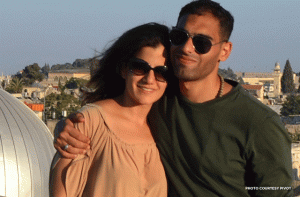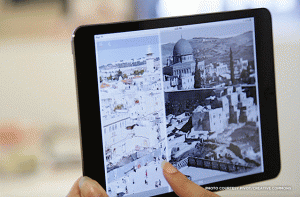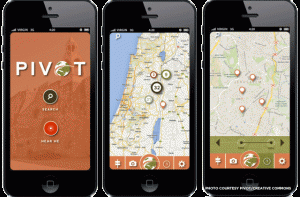By Jamesha Gibson
Preservation Nation
Preservationists know how difficult it is not only to protect, but also interpret cultural landscapes that are in highly vulnerable or frequently transitioning circumstances.
Asma Jaber and her fiancé Sami Jitan saw the extent of this dilemma as they witnessed the endangerment of many historic sites while studying in Palestine. In response, the couple created an app called PIVOT.
Using a high-quality, open-sourced platform, PIVOT (which launches in November) will give users access to streamlined digital cultural preservation in places where cultural heritage and history are at risk and in places that have suffered a decline in tourism and/or have rich tourism potential.
Recently, we got the opportunity to talk with Asthma Jaber about what inspired PIVOT’s creation, how the app will work, and what could be its overall impact on the preservation world.
 Asma Jaber (left) and Sami Jitan (right) are the co-founders of the PIVOT app.
Asma Jaber (left) and Sami Jitan (right) are the co-founders of the PIVOT app.
What inspired you to create this app?
The creation of the app is very much a personal story. I had no intention of becoming an entrepreneur or creating any kind of app related to accessing history.
I grew up in South Carolina with Palestinian parents, and I grew up hearing stories of their history, stories of their past, [and] specifically stories of places that they knew intimately. A lot of these places had been destroyed, or are currently under threat of being destroyed, and so [my dad] recalled them to me as he remembered them. I grew up re-living them [and] with a vivid imagination of what these places must have looked like when he was a young adult.
When I grew up,] I started graduate school at the Harvard Kennedy School [pursuing a] Master of Public Policy. While I was in graduate school, my dad passed away in a tragic car accident (my mom survived). I was actually in Palestine, mapping out his home village, at the time that I found out. So I boarded a flight and came back [to the U.S.]. I wanted to give myself time to grieve and take care of my mom, who was recovering from surgery, [so] I delayed graduate school by a semester.
When I came back to graduate school, I really wanted to do something to honor the history of my dad’s village, [so] I went to the Harvard Innovation Lab — it’s a co-working space to help students take their ventures and ideas to the next level–and I said, “Hey, I have this idea for making an app that I want to do for my dad’s village only.” I didn’t really think about creating it into a business or creating it into a social enterprise where you can scale it out all over the world, but they loved the idea and they encouraged me to enter it into a competition at the Harvard Innovation Lab. So we entered the app into the Deans’ Cultural Entrepreneurship Challenge and we won Grand Prize.
That was about a year ago and now we’re launching it in Cambridge at Harvard Square in November.
What is the goal of the app, and what will it do?
The goal of the app is basically to help streamline access to history. To help connect people to the histories that matter to them, especially for places at risk of being lost or destroyed or the history is not fully captured.
 Using photos from the public domain and photos gathered from the public via crowdsourcing, PIVOT will allow users to experience historic sites throughout various time periods.
Using photos from the public domain and photos gathered from the public via crowdsourcing, PIVOT will allow users to experience historic sites throughout various time periods.
So that is the mission, and it’s to do so in a streamlined way because right now, [for example], if I’m walking in downtown Boston or I’m walking in Bethlehem, Palestine, and I want to know what happened in this exact location and the history of this place I probably have to Google search, get to Wikipedia, maybe look at some Google images or a random website. But there is no easy, [user- friendly] way to streamline information about a particular place over time and help people learn or connect with the history.
What is your photo research process? How will what you find be translated to the app?
Basically we exhaust public domain archives. For instance, if we are doing Harvard University. we will go into the library and archives there. Or, we will have students trained in archiving, history, and historic preservation to do the research. Then we’ll have this sorting mechanism digitize the photos and upload them into our Content Management System, which is a web dashboard, and this feeds directly into the mobile app.
For images that we know their location, and many of them in the archives have a street corner or a rough estimation, we try as accurately as possible to estimate where they are. This is all done manually, but at the same time we’re working on automating this process using the Computer Vision or Map Image Recognition (where you can take Google street view and match it, with the highest level of accuracy as possible, to an old historic image).
So we have two data sources: one data source is the institutional archives, and the other source is people’s content [via] shoebox archiving or crowd sourcing. We haven’t started that yet; we’re studying the best practices of how to implement it with a high level of accuracy.
What do you hope to teach and invoke in your audience when they use this app?
We hope to teach people to have a greater appreciation for places and their history and to be able to connect with places in a deeper way, to have people excited about history again. The hope is that this [app] will promote historical learning and the preservation of places. [We hope that] in general, when somebody appreciates or learns about a place, they will become more intimately attached to it and to its preservation.
 PIVOT will afford users streamlined access to digital cultural history. The app will focus on places where cultural heritage and history are at risk.
PIVOT will afford users streamlined access to digital cultural history. The app will focus on places where cultural heritage and history are at risk.
How can the public help with the development of this app?
I think in the locations where we first launch– for example, Harvard Square in Cambridge at the end of the year, and then maybe expanding to Boston, and then going to Bethlehem (these things are to be determined, of course) — having people input data that we may be overlooking or [sharing] a treasure trove of images that we may not have even known about in a collection.
Also, input and advice about what places would have a great use of [this] application, because though we have a strategy of where to go next and how to scale out I think people who are in the space, especially people in tune with the National Trust for Historic Preservation, will have a great deal of input on target audiences, networks, UNESCO World Heritage Sites, and how to scale the app out to their locations as well.
Have info or tips you want to contribute? Check out PIVOT’s email service and beta testing program.
The National Trust for Historic Preservation works to save America’s historic places. Join us today to help protect the places that matter to you.



